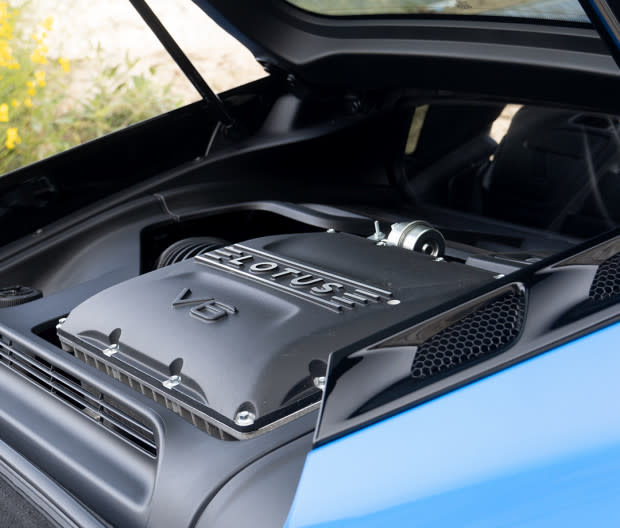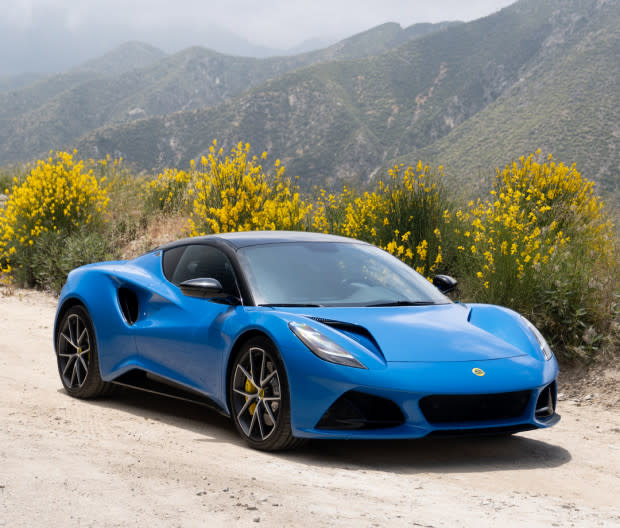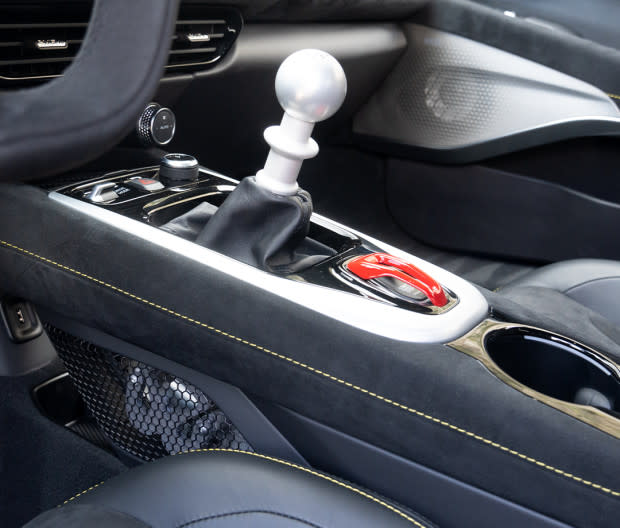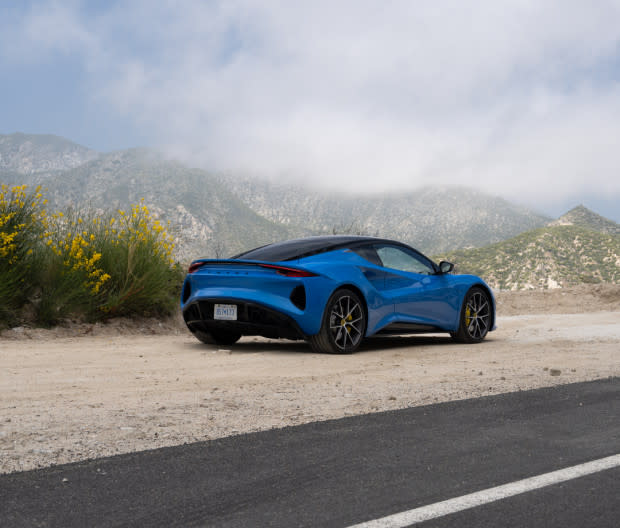First Drive: Lotus Emira Steers a Classic Supercar Brand Into a New Era
By the end of this year, Lotus hopes to finally begin customer deliveries of the Emira sports car in the U.S. It's got big shoes to fill, following 12 years of the mid-engined Evora and tasked with helping Lotus transition towards more modernized production methods under Geely conglomerate ownership at the headquarters in Hethel, England. The new supercar will also carry founder Colin Chapman’s torch as the company’s last internal-combustion sports car before the inevitable transition to full electrification.
Lotus executives last year minced no words when I asked whether Emira specifically targets Porsche’s 718 Cayman and Boxster siblings, especially the GT4 and GT4 RS. If that sounds like enough of a challenge, Lotus also aims to significantly update the style and interior ergonomics that Evora entirely lacked, while improving performance and driver feedback.
As the automotive industry awaited one of the most highly anticipated sports cars in years, whispers swirled around how such a major leap into the modern era under new ownership might effect the classic Lotus spirit. Finally, this spring, a pair of press loaner Emiras arrived in the U.S. to answer questions about whether contemporary Lotus creations can still follow Chapman's creed of “simplify, then add lightness.”

Michael Teo Van Runkle
Two Trims and Two Engine Options
Whenever the real deliveries begin, Emira will be offering a choice of two trims and two engine options. A supercharged 3.5-liter V6 carries over from Evora, borrowed once again from Toyota and paired with a six-speed manual transmission. Lotus also sourced a turbocharged inline-four from AMG which comes with an eight-speed dual-clutch automatic. Buyers then face the decision between Tour and Sport trims, which lightly revise the suspension and tire setup to prioritize either the sharper or smoother of Emira’s dual (some might say dueling) personalities.
The V6 receives ratings of 400 horsepower and 310 lb-ft of torque, with fuel cutoff at 6,550 rpm and momentary mechanical rev limit of 6,800 rpm. The manual gearbox contributes to a curb weight of 3,212 pounds and weight distribution that biases 61.7 percent to the rear—this is still a mid-engined coupe, remember. That four-banger from AMG, meanwhile, peaks lower at 360 horsepower here in the U.S. (an S variant with up to 416 hp is available to the rest of the world) but delivers more torque, at 317 lb-ft.
Related: First Drive: 2023 Lamborghini Huracán Tecnica
Lotus brought two Emiras—one Tour and one Sport—in First Edition spec for the automotive press in the U.S. Both were equipped with the V6, and thus, thankfully, with the manual. The six-speed undoubtedly falls more in line with the analog driving experience that longtime Lotus fans crave, though for low-end boost and snappier shifts, the automatic might make sense for daily driving or shaving lap times on track.
As manuals continue to trend towards extinction, the message seems to be that we should be glad Lotus even decided to move forward with a stick shift—though the fact that the V6 now puts out less power than an outgoing Evora GT seems somewhat counterintuitive.
I also found myself a bit surprised that Lotus handed me the Tour trim rather than the Sport, which translates to softer suspension damping and sway bars, less aggressive alignment, and less grippy Goodyear Eagle F1 Supersport tires. But driving from West L.A. to the nearest canyons without a ton of pranging off each tiny road imperfection, I immediately remembered the harsh ride of the Evora GT. Manually adjustable suspension will be available as a dealer option, though not on First Edition cars.

Michael Teo Van Runkle
Stunning Supercar Styling
Regardless of viewing angle, Emira delivers a massive update on the Evora’s styling, with miniaturized supercar cues that hew closely to inspiration from the likes of McLaren, Ferrari, and possibly even the revived De Tomaso P72. The swooping and angular intakes transition to a wide tail with almost steroidal haunches—all without approaching the sheer bulk that many true supercars (read: larger supercars) tend to occupy up close.
The exterior lines establish Emira as a true exotic, turning the heads of both those who know and those who don’t quite understand what they’re looking at. Climbing into the low cockpit, the major interior revamp stands out as even more of an important evolutionary leap. At 6’1” with long legs, I just about maxed out the Evora GT’s interior leg and headroom due to the 2+2 layout.
Not so in the two-seater Emira. In fact, I actually needed to scoot the driver’s seat forward because the previous driver stood a full 6’8” (with size 14 shoes) and somehow fit just fine in this diminutive Lotus.
Related: Lucid Air Is the Only EV Worth Road-Tripping With
A new dash design drops the hilariously outdated Alpine head unit in favor of a true integrated 10.25-inch touchscreen with OEM-level user interface, plus a 12.3-inch digital gauge cluster that changes configurations, depending on drive modes adjustable via a dial on the center console. Exposed linkages below the shifter knob serve as another reminder of the old-school mechanical engineering that makes Lotus a standout in an industry trending towards heavier, overly computerized “sports cars” that increasingly drive more like grand tourers.
As a new model, comparing Emira so directly to Evora seems unfair. Almost 15 years have passed since Evora debuted. But under the svelte skin, the two cars still share plenty of chassis components, even if Lotus claims the Emira received a new tub and subframes to allow for a two-inch wider track, as well as the massive improvements to interior ergonomics.

Michael Teo Van Runkle
Demanding Old-School Lotus Driving Dynamics
The Tour suspension felt soft enough on city streets and highways headed up to the hills, with none of the jouncing or tramlining that made Evora so tough to drive. The front alignment almost seemed happier turning than going straight. As soon as the first tight canyon corner allowed me to set the little car’s edge, though, the alignment that formerly felt like a bit too much toe-in all of a sudden transformed into my best friend.
I typically try to ease into serious driving, pushing incrementally further toward the limits of straight line speed and hard cornering. Not so in Emira. Even in the Tour spec, on public roads, wearing those Goodyears, I nudged up past 1g of lateral acceleration almost immediately. So light, so much grip, so much feedback through the hydraulic steering—no electronic assist here, as on Porsche’s 981 Cayman and Boxster. Soon enough, the in-dash g meter started reading 1.3, 1.4, all the way up to 1.5g on my usual test roads, where the best sports cars typically max out at 1.2g or less.
As my neck adjusted to sheer cornering forces, I also needed minimal time to acclimate to the six-speed, which carries over from Evora with a slightly longer shift throw than most other contemporary sticks. The short travel of the clutch pedal allows for perfect up and downshifts, with easily reachable throttle blips despite the top-hinging accelerator pedal. The transmission even balked while downshifting into second a few times—truly classic Lotus Evora behavior.
Evora originally stood out from previous Cayman and Boxster generations thanks largely to a lower and lighter chassis paired to a supercharged V6 that put out far more low-end grunt than Porsche’s flat-six engines. But the top-spec, mid-engine Porsches made up serious ground in the interim years, to the point that the immediate punch from the Emira’s supercharged V6 feels a bit blunted.
In fact, compared to the outgoing Evora GT, Emira receives slightly lower power ratings, while that relatively low 6,550-rpm redline and fading top-end intensity prompted me to actually start short-shifting well before reaching fuel cutoff.
Related: 13 Best Men's Luxury Watches of 2023, From Rolex to TAG Heuer
Straight line speed seems more important in a car with borderline supercar styling, but the truth remains that neither Emira nor Evora ever aimed to dominate drag strips. Instead, Lotus demanded nimble driving dynamics from the little coupes. Without a doubt, Emira manages to deliver that same level of real-world cornering.
The Tour trim’s softer ride might even contribute to slightly more perceptible levels of body roll, before easing into throttle shifts the rear-biased weight back towards tail and prompts access to throttle-induced oversteer.
Back onto straights, the V6’s exhaust sounded surprisingly tame, with just a hint of supercharger whine and minimal road noise intruding into the passenger compartment. Opening up the windows even a crack allows more exterior aural cues to overcome Emira’s increased sound deadening compared to Evora, though. Especially in Sport mode, the exhaust roars through revs, with supercharger screaming and throttle liftoff producing plenty of pops and bangs. Then even a light touch of the brake pedal hauls down speed immediately, prompting a bit of tail-happy shimmying into the next corner.
Closing the windows again cocoons the interior in near silence once more. No pebbles ricocheting off wheel arches, no more tire and road hum, and no more wind noise to go with the Evora’s more aggressive exhaust note. In fact, Emira’s eminent performance capability pairs with comfort never before felt in any Lotus, reaching a level of refinement that almost dulls the expressive, exotic edge which formerly helped Evora (and Elise and Exige) deliver old-school Lotus vivacity.

Michael Teo Van Runkle
Rushing into the Modern Era
For any potential buyers accustomed to other sports cars on the market not handmade in Hethel, the Emira—when equipped with the V6 and manual—will still undoubtedly deliver an analog spectacle that’s become entirely absent in the modern era. Even the supercharger’s mechanical bypass valve, visible in the rearview mirror and actuating with every mash of the go pedal, serves as a reminder that compressed air and gasoline come together to produce explosions and move pistons and spin crankshafts and rod bearings and axles and wheels and tires.
Speaking of rearviews, the new two-seater design also radically improves visibility out of Emira’s low-slung cockpit. Even the side mirrors work well. Inside, the new Lotus aesthetic creates a much more familiar environment, to the point that Porsche’s tiny touchscreens and busy buttons seem outdated, too. The sacrificed second row, which came with Velco rear seat pads on Evora anyway, never seems like a true sacrifice. Emira isn’t a 911 competitor, after all.
The lack of a frunk and only a tiny rear trunk (which heats up with the engine) does limit daily practicality. If Lotus ever cared a lick for such concerns, an Emira in Tour trim would probably be that car. And while hauling through canyons pulling 1.5g, wishing for a bit more rawness rather than refinement, I wondered whether the Sport trim may well deliver that next level of engagement. I’d miss the softness of the Tour suspension setup most of the time, so manually adjustable shocks sound good, as do more aggressive Michelin tires.
Related: Kickstart Your Year: The Best New Motorcycles of 2023
What about a turbo-four paired with the six-speed? Well, Lotus buys the AMG engine and transaxle as a unit, so that possible combo seems out the window, even if the building rush of turbo boost would be undeniably awesome when paired with a manual. Same with the prospect of a higher redline, since the mill can manage 7,200 rpm as currently used in the CLA 45 S (which puts out 416 horsepower, too).
The longer I drove Emira, the more I wanted to drive, even with my mild hesitations about the gap between a modernized machine and bygone levels of Lotus-ness. Running errands transformed into engaging races around town—an achievement that only the rarest sports cars can manage.
So did Lotus execs manage to achieve their goal of taking on Porsche? Well, indefinite pricing definitely muddles the equation. Lotus claims the First Edition V6 manual I drove cost $96,360. Base cars were originally promised as low as $74,600. Current First Edition builds start at $105,400 (or about $10,000 more than early First Edition orders). Inline-four cars will cost less versus the V6, but without concrete confirmation from Lotus, expect stickers to range from the high $80,000s to well over $90,000 when true series production begins.
For comparison, a 718 Cayman GT4 starts just over $100,000 and the GT4 RS sits far higher at nearly $160,000 (before tacking on any of Porsche’s endless list of options). All else equal, I would take an Emira before both, just for the better looks, improved interior, more exotic nature, and impressive communication between driver, car, and road.
But Porsche’s often-overlooked sweet spot, the 718 Cayman or Boxster in GTS 4.0 spec, still takes the cake. Built by Porsche’s road team rather than the Motorsport department that turns out GT cars, the GTS 4.0 prioritizes driver engagement at all times rather than only at the limits.
Sure, the GT4 and GT4 RS can slash whole seconds off lap times, but that track performance comes at the cost of all-rounder fun. A Cayman GTS 4.0 stickers for $90,300 and up, though, with just a few popular options easily ratcheting that number into six figures.
Below or near $80,000 as originally intended, Emira slots in as the kind of screaming deal that only a C8 Corvette might have matched over the past few years—and Emira comes with a good-old-fashioned stick shift. My own Emira, whether a Tour or Sport, would immediately receive better tires and a more dialed alignment, plus the adjustable suspension if available. But out of the box, this mini supercar undeniably nails a whole lot. Hopefully Lotus can continue to refine the package as new production processes at Hethel continue to develop.